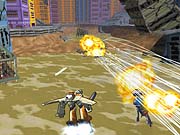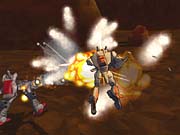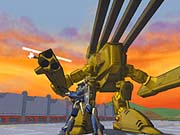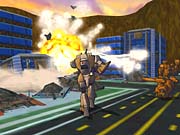Robotech: Battlecry Q&A
We chat with Eric Peterson of Vicious Cycle and Carlos Rodriguez of TDK to get the latest on the upcoming multiplatform Robotech game.
When Robotech was aired on North American TV for the first time back in 1985, its unique visual style and relatively dynamic storyline almost instantly attracted throngs of fans. However, while Japanese developers have since capitalized on Robotech's popularity by releasing games for nearly every system, fans in North America have been left with nothing--until now. The development team at Vicious Cycle is currently working on Robotech: Battlecry for the GameCube, the PlayStation 2, and the Xbox. The game will feature cel-shaded graphics, and it will give you an opportunity to pilot the transformable veritech fighter in a variety of missions. We had a chance to speak with Carlos Rodriguez, producer of Robotech: Battlecry, and Eric Peterson, president of Vicious Cycle, to get some information on how the project came together and what the development team has in store for the game.

GameSpot: Can you give some background on the team working on the game?
Carlos Rodriguez: The team is an experienced group of developers that emerged from a studio in Chapel Hill, North Carolina, two and a half years ago to form the company known as Vicious Cycle Software Inc. Initially, Vicious Cycle was working on a superhero product for Mattel. Mattel then decided to shelf that product for a more recognizable license. The developers were extremely excited to be chosen for the challenge and were ready to overcome any odds to create a great game based on the anime classic.
GS: Are most of them Robotech fans?
CR: Yes, most of them are. In fact, some of them are just huge fanboys like anyone else. They want to give every Robotech fan a great experience and a great game; after all, they too would want nothing less.
GS: When working with a license like this, how difficult is it to come up with a general gameplay concept?
CR: General gameplay wasn't that difficult of a challenge, actually. The developers knew what they wanted from the beginning--lots of action, as many enemies as possible, and the ability to transform whenever they wanted. The secondary gameplay mechanics were a bit more difficult to develop only because the team wanted to stay true to the license. Many secondary actions were developed, like using the sniper view in battloid mode, picking up objects as the guardian, and throwing off missile decoys as the jet. Even some other gameplay elements were added just because they were cool--like the ability to shoot down individual volleys of missiles while in a heated battle. Now if that's not Robotech, then I don't know what is!

GS: The Robotech game that Gametek was working on put players in the cockpit of the veritech. Was there any desire to go that route instead of third-person?
Eric Peterson: Not at all. In fact, the game doesn't have a cockpit view--unless you consider a sniper view a type of cockpit. The main reason behind this decision was that the team didn't want to create a flight sim. They didn't want the game to function around one-third of the veritech's abilities. The other two modes of the veritech have their place in the show, and the developers wanted them equally represented. For example, Battlecry has numerous ground battles in cities, and it was only logical to allow a player to maneuver as a battloid for those missions. Another important reason for going third-person is the intensity of the action, which includes a vast number of corkscrewing missiles, as well as extremely fast-paced maneuverability. Without the third-person view, the player wouldn't get the full experience of the battles that appear in Robotech. Not to mention, the veritech that the player controls looks pretty awesome cel-shaded--and most importantly, the developers didn't want any Robotech fan to be unable to see themselves transform.
Tell Us About Protoculture

GS: Did the development team use any of the Japan-only Robotech games as a reference? Why do you think these games were relatively unappealing to fans?
EP: Yes, they did. In fact, most of the core team played all of the Japanese imported Macross titles. The controls for most of the games that you are referring to had steep learning curves. The developers felt that they needed to be able to move, transform, and attack with ease. Therefore, the controls in Battlecry are extremely easy to get accustomed to.
GS: Was the decision to use cel shading made early, or was it something that was adopted later on in the project?
EP: It was made very early in development. The team tried a more metallic look with specularity initially, but the veritech just ended up looking like every other mech on the market. Cel shading not only assisted in rooting the game to the original cartoon, but also helped when going head-to-head with the competition. Staying true to the license was extremely beneficial, and for Robotech, it isn't a gimmick.
GS: Is the mission structure linear, or can players choose between missions?
EP: Battlecry is a combination of linear and hub-based missions. At any one time, the player has missions to choose from, but the player has to complete all of the missions to advance through the story. This methodology allows a player to play another level if one proves to be more challenging than the next, although the player will have to return to the challenging level and win before moving forward through the plot. Ultimately, the game has only one beginning and one ending.
GS: How is the multiplayer aspect of the game turning out?
CR: It seems to be popular with the fans, that's for sure! The success of the two-player versus mode via split-screen was a definite hit at the Robotech booth at E3. Battles take place in many of the best environments from the game. One-on-one battles really demonstrate the true feeling of Robotech--it incorporates speed of play, fast reflexes, and reaction time from two human players, all of which makes it all the more satisfying. And every fan will want to have the bragging rights among his or her friends when it comes to who the best veritech pilot in the RDF really is.

GS: Anything you would like to tell the Robotech fans who have been waiting years for a Robotech game to come to North America?
EP: The team knows that the fans are out there, and they try to communicate with the fans as often as they can. Vicious Cycle has worked extremely hard to create the best game possible for the fans without alienating the everyday consumer. They really wanted to reach as many people as possible--old and new alike.
GS: Thanks for your time, guys.
Got a news tip or want to contact us directly? Email news@gamespot.com
Join the conversation